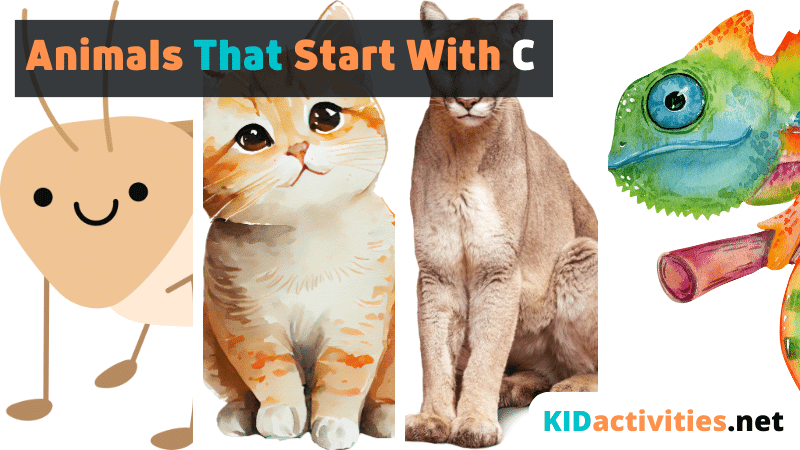Below is a complete list of animals that start with the letter C and with additional information about each which can make a great resource to teachers and parents alike.
In the vast assortment of our natural world lives an extraordinary variety of animals, each holding its unique place in the music of life. On our extraordinary journey into the animal kingdom, we found out that the letter “C” indicates an exhibition of enthralling creatures.
Quick Summary
| Cat | Cow | Chicken |
| Crocodile | Cheetah | Chimpanzees |
| Camel | Coyote | Caracal |
| Capybara | Chinchilla | Chipmunk |
| Crab | Clownfish | Condor |
| Cobra | Cuttlefish | Caimans |
| Coati | Cassowary | Caiman Lizard |
| Cockatoo | Cougar | Cormorant |
| Crayfish | Collie | Cottonmouth Snake |
| Cricket | Cuscus | Cichlid (Fish) |
| Coral | Coelacanth (Fish) | Crowned Crane |
| Civet | Caterpillar | Chameleon |
| Chi Chi | Chartreux | Cheagle |
| Chimaera | Chipoo | Corella |
| Cuckoo | Conger Eel |
Join us on our exploration of the fascinating creatures named with the letter C. In this article, we’ll discuss a variety of beings with their own stories, from well-known buddies to amazing creatures that live in the wilderness and in the deep ocean.
Take a step into the beautiful world of the Cheetah, which rules the savannah with unmatched speed and elegance. Discover the majestic Camels, that survive harsh conditions in the desert.
Get up close and personal with the king predator of its realm, the clever and cunning Crocodile. But the journey doesn’t end there; it only begins. As we experience nature you will be amazed by the dazzling colours of Clownfish dancing gracefully among coral reefs.
Discover the ancient mysteries of the Coelacanth, a living fossil that connects us to our evolutionary heritage. The nocturnal Chinchilla’s mysterious eyes and the vibrant parade of colorful Cockatoos taking flight in the tropical skies are just a few of the secrets revealed by the animal kingdom’s “C.”
Our journey around the globe will reveal stories about survival, adaptation, and coexistence – tales of courage, nurturing, and survival instincts that define these remarkable creatures.
Take part in this enthralling tour with us as we learn about 44 animals with names that start with the letter “C.” Each discovery will spark a burning curiosity about protecting these precious species for future generations, as you gain a deeper appreciation for the intricate web of life that connects us all.
Get ready for an unforgettable journey into the enchanting world of animals starting with “C”.
List of 44 Animals that start with the letter “C”
1. Cat

Cat is an absolute dilemma for humanity but also a mesmerising and fascinating companion. Cats, with their mesmerising grace and independent nature, have long captivated human hearts.
These enigmatic animals have an aura of mystery, from their seductive eyes to their liquid movements, making them fascinating and precious to humans. With a history steeped in cultural significance, cats have been revered in ancient civilisations and cherished as symbols of agility and cunning.
Apart from their captivating charm, thanks to their sharp senses and agile reflexes developed over the ages of evolution, cats are also exceptional predators. Whether they’re hunting or playfully chasing toys, their natural abilities never fail to impress.
Beyond their independent behavior, cats can form strong bonds with their human families, expressing affection through soothing purrs and gentle gestures.
As both royal guardians of our homes and loving buddies, cats continue to hold a special place in our hearts, leaving a lasting impression with their fascinating presence.
2. Cow
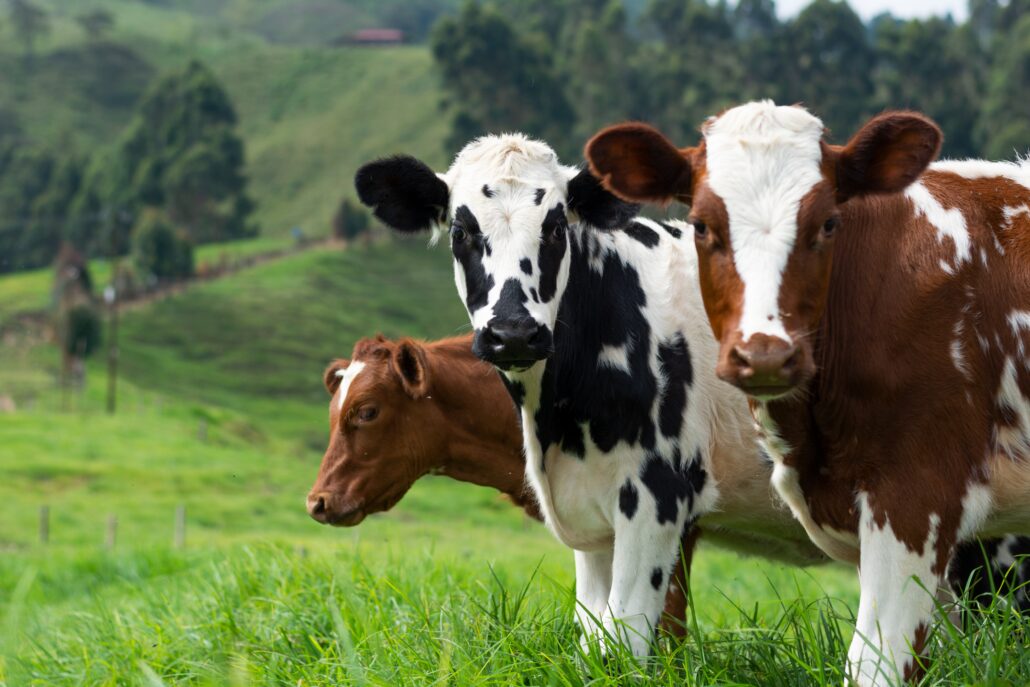
For millions of years, cows have had a recognisable and important role in human society and domestic lives as they have made crucial contributions due to their giving and gentle nature.
Cows helped a lot in human growth and development as they always provide milk and meat (as food) but also they offered plenty of assistance in the agricultural works.
It is no mistake that their presence on idyllic farmlands, as well as the soothing sound of their mooing, have become enduring symbols of pastoral life.
Despite their large, soulful eyes and endearing nature, cows have cemented their position in the souls of people around the world as precious and special friends.
It is worth noting, that cows, as well as their effectiveness for development and survival, have a significant picture and importance in many religions around the world.
For example, Hinduism considers cows sacred and reveres them as the embodiment of divine and maternal qualities. Many parts of India and other regions influenced by Hindu tradition view their protection as a moral and spiritual duty.
3. Chicken
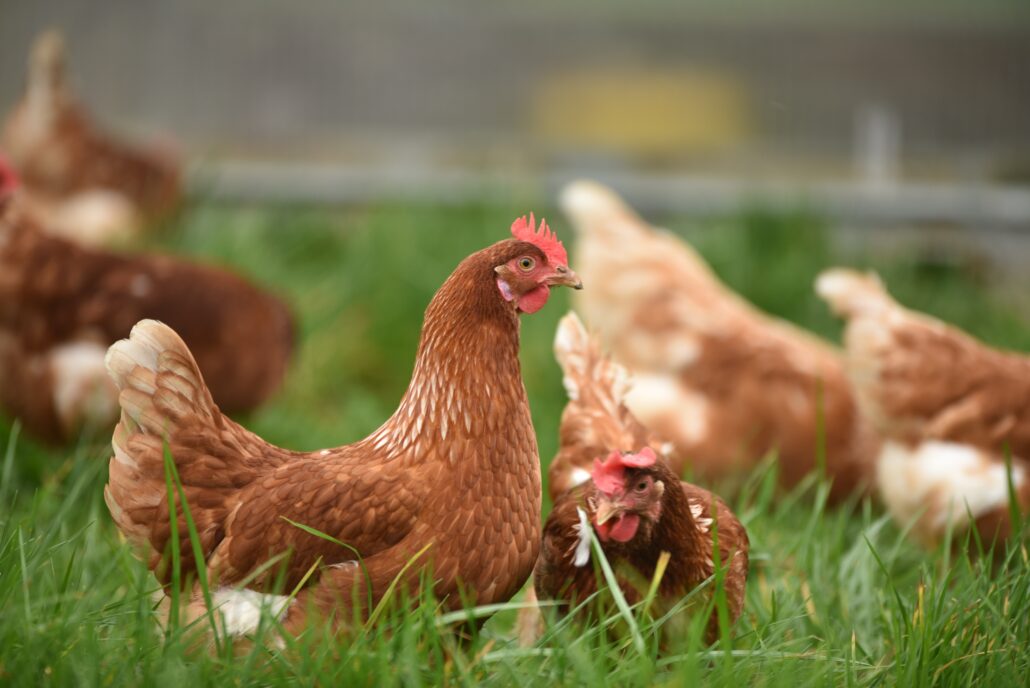
Chickens are not only ordinary birds, that we can find in our daily lives easily but are also animals with high importance for human lives around the globe.
Chickens are found in most farms around the world and they hold a significant role as a source of food for many people. Chickens give eggs and meat and they are a great source of protein in our nutrition.
It’s a fact that they are the most common food source that supports both human well-being and power. In regions that are not rich enough, chickens may be their only source of protein.
Aside from their utilitarian value, chickens have carved out a place in various cultures. From children’s stories to idioms and expressions, chickens have woven themselves into our language and folklore, adding charm and whimsy to our narratives.
Their distinctive clucks, cackles, and crowing sounds have become recognizable symbols, evoking images of farm life and pastoral landscapes.
Chickens’ curious and amusing behaviours have also made their way into popular media, with animated characters and caricatures bringing joy and laughter to kids and adults.
It is worth mentioning that chickens have the ability to adjust in all climates and environments; that’s why they are accessible easily to all people around the world, from all the different walks of life ( urban life or backyards ).
However, they are not only accessible but that are also affordable. Those two qualities make them easy to take care of. We can highlight that chickens are almost self-sufficient.
4. Crocodile
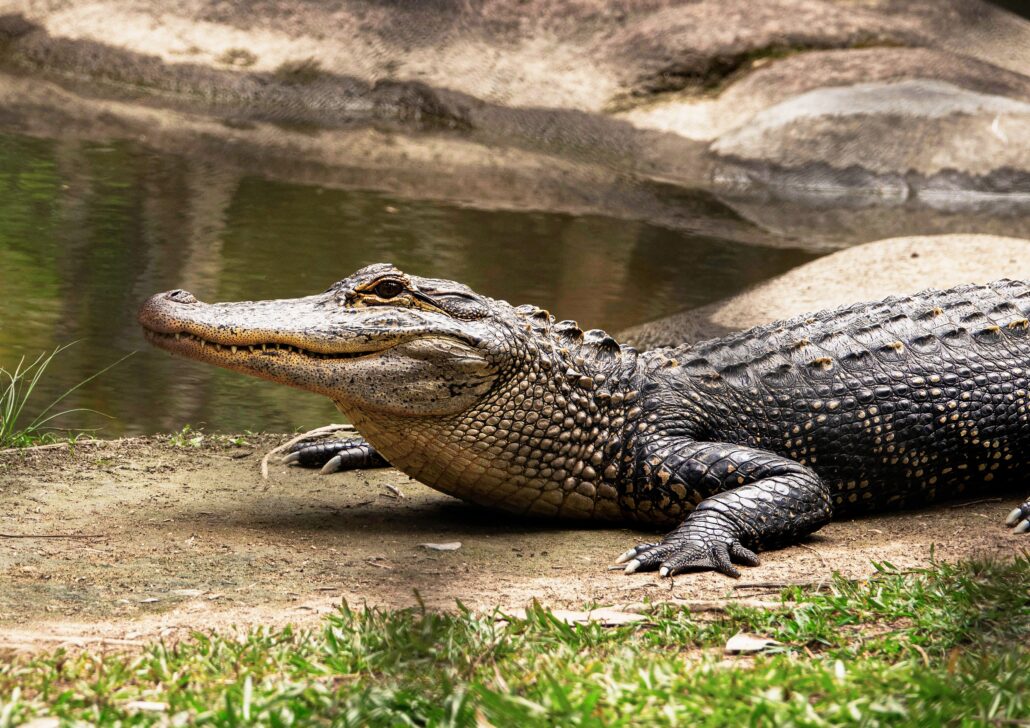
Crocodiles are remarkable creatures that play crucial roles in their ecosystems. As apex predators, they help control the populations of other animals, ensuring a healthy balance in the environment.
With their powerful jaws and sharp teeth, they efficiently hunt various prey, including fish, birds, and mammals, which prevents any one species from dominating and maintains biodiversity.
Beyond their ecological significance, crocodiles hold historical and cultural importance. Revered in ancient civilisations, they have become symbols of strength, resilience, and protection in local myths and folklore.
Additionally, crocodiles act as environmental indicators, sensitive to changes in their habitats. Monitoring their populations can provide insights into the overall health of their ecosystems, making them valuable tools for conservation efforts and understanding the well-being of the environment.
5. Cheetah
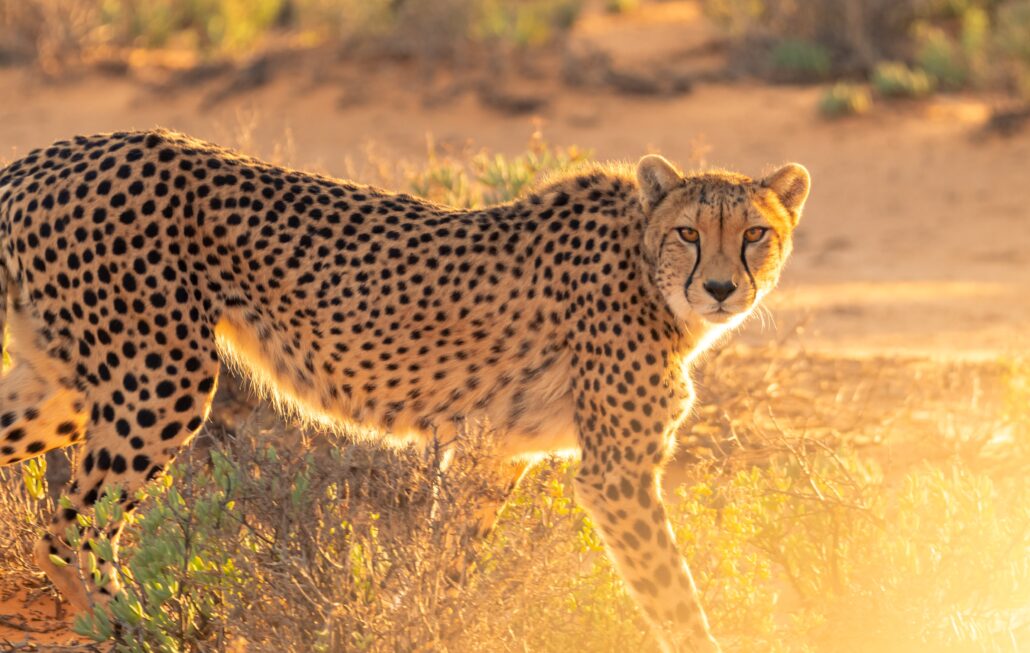
Cheetahs are incredible big cats that are mostly known for their speed, sleek, and spotted coats. Their beauty and fascination attract attention all the time.
Their speed can reach 70 miles per hour in a short period of time, making them one of the fastest animals. They are highly effective hunters who mainly hunt gazelles and impalas due to their slender bodies and long legs.
Despite their incredible speed, cheetahs still face many challenges in the wild. These animals face a number of threats, including habitat loss, human-wildlife conflict, and the decline of prey species.
To ensure that these majestic creatures can live for a long time to come, it is imperative that they be conserved for future generations.
6. Chimpanzees

Chimpanzees are one of the most intelligent animal species in the world and they share high similarities with humans when it comes to intelligence and social life.
It’s impressive that 98% of their DNA matches our own. In chimpanzee communities, families and friends form strong bonds, just as they do in ours. The gestures and vocalisations they use to communicate show that each understands the emotions of the other.
A chimpanzee is an excellent problem solver and also uses tools to find food, such as sticks for extracting insects from tree bark. They will also comfort each other when they are distressed with empathy and compassion.
Even though chimpanzees have excellent and super-strong abilities they are still threatened by habitat loss and poaching. That’s why it’s more than important to make huge conservation efforts.
The natural habitat must be protected at any cost in order for chimpanzees to remain alive in the wild and continue their important role in the ecosystem.
7. Camel
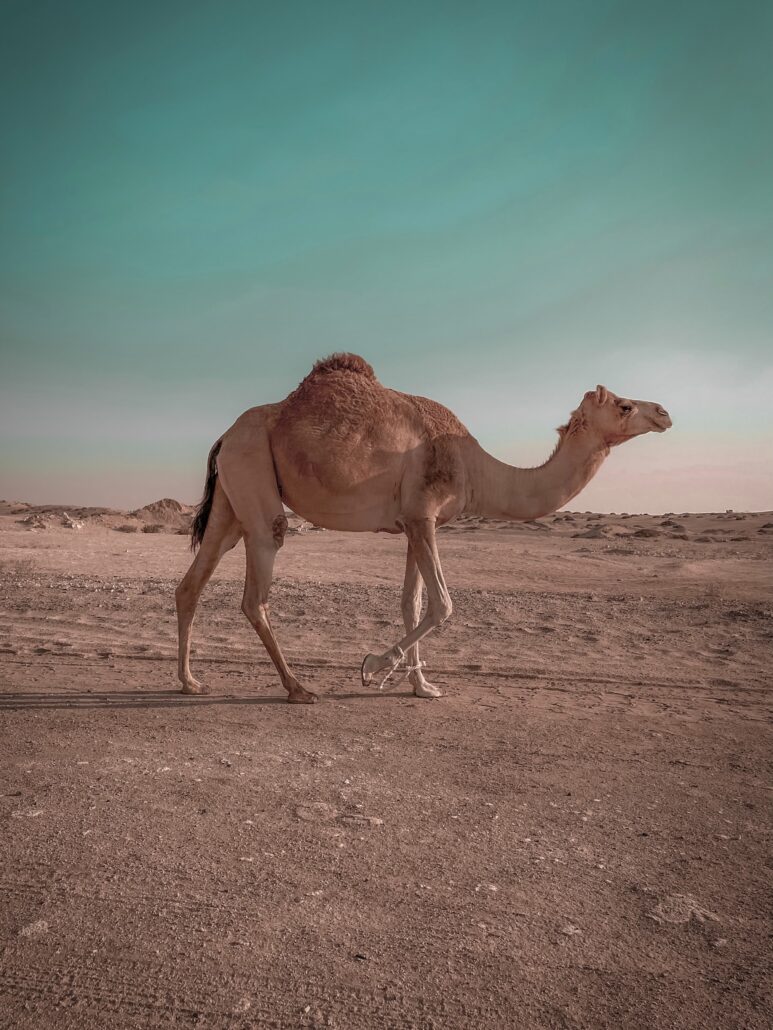
Camels are fascinating creatures specially adapted to thrive in the harsh desert environments. With their iconic humps, camels can store fat that provides them with energy when food and water are scarce.
Their long legs and padded feet help them walk effortlessly on sandy terrain, and their thick eyelashes and ear muscles protect them from sand and heat.
Camels have been invaluable companions to humans for centuries, serving as reliable means of transportation and carrying heavy loads across vast stretches of arid lands.
Their ability to survive for long periods without water and their nutritious milk have made them indispensable assets to communities living in desert regions.
Despite their resilience, camels face challenges in the modern world. As their natural habitats are threatened by human activities and climate change, conservation efforts are crucial to safeguard these magnificent animals and preserve the delicate balance of desert ecosystems.
Embracing sustainable practices and promoting responsible tourism can help protect the unique cultural and ecological importance of camels, ensuring that these enduring creatures continue to thrive in their harsh but beautiful desert homes.
8. Coyote
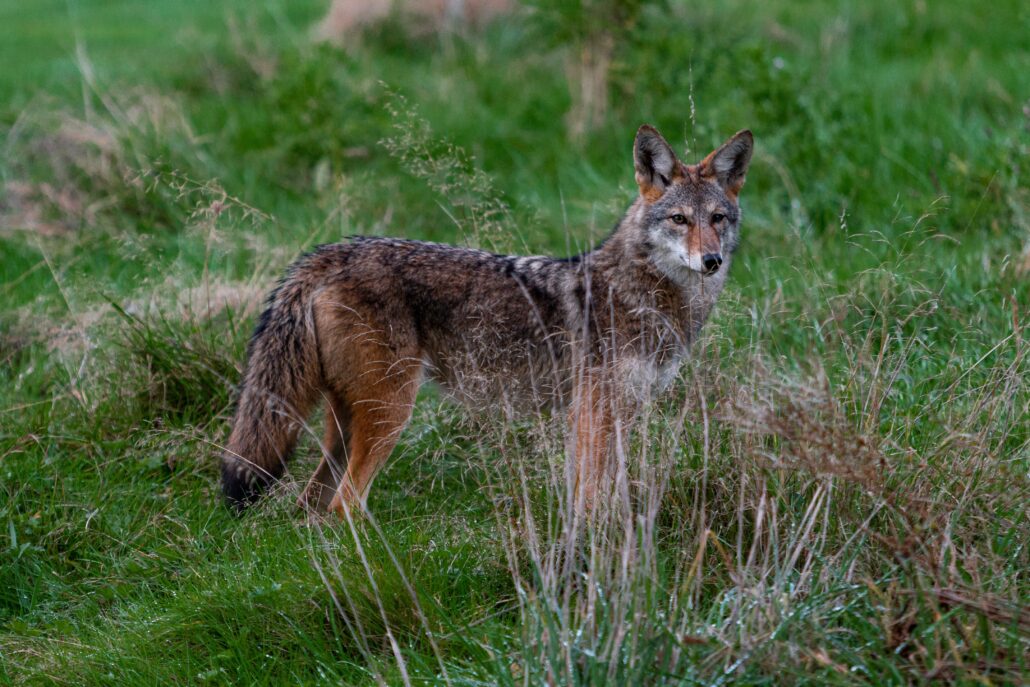
The coyote is a highly intelligent and adaptable animal that lives mainly in Central and North America. The opportunistic omnivores eat small mammals as well as birds, fruits, and insects.
From forests to urban areas, they have successfully coexisted with humans due to their ability to adapt to a variety of environments. Coyotes must control rodent populations in order to keep ecosystems in balance.
Despite their ecological significance, coyotes sometimes face conflicts with human activities, especially in urban areas. They may scavenge for food scraps and encounter human pets, leading to misunderstandings and challenges.
However, it is essential to find ways to coexist with these intelligent and resourceful animals, implementing measures such as secure garbage disposal and responsible pet ownership. By understanding and respecting the role of coyotes in their ecosystems, we can foster harmonious relationships with these remarkable creatures.
9. Caracal
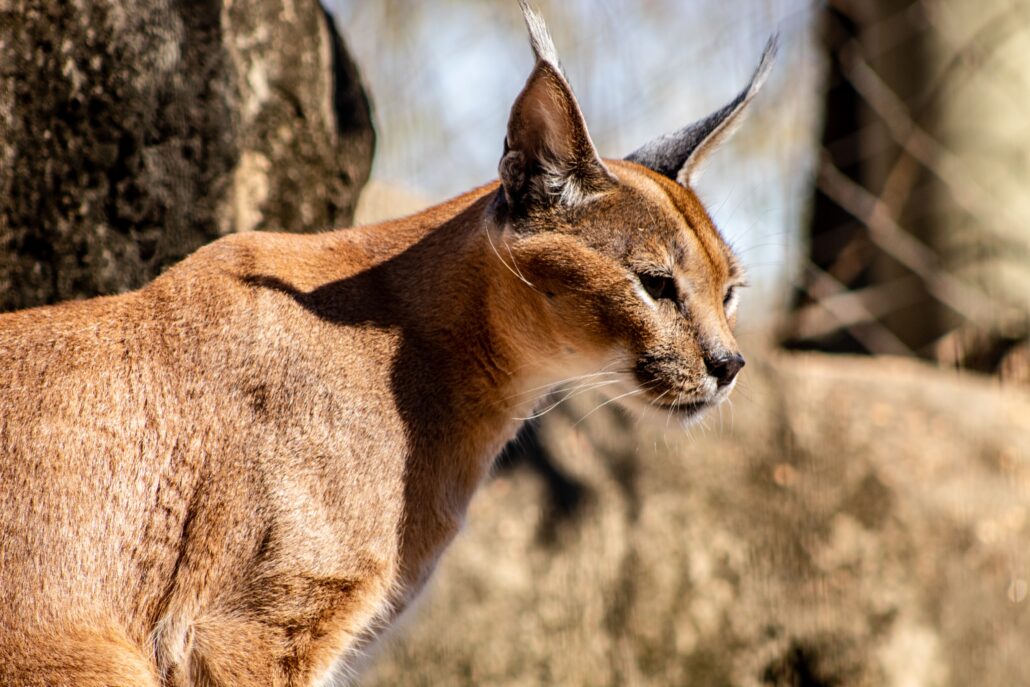
African, Middle Eastern and South Asian regions are home to the graceful and agile caracal. With distinctive tufts of black fur on its ears, the caracal is known for its striking appearance.
As a skilled hunter, this magnificent predator can leap high into the air to catch birds in flight and even take down larger animals. Its powerful legs and sleek body make it a formidable and stealthy predator in its natural habitat.
As with many wild cat species, caracals face challenges due to habitat loss and human-wildlife conflicts. Preserving their natural habitats and implementing conservation measures are vital to ensure the survival of these captivating creatures.
The conservation of caracals and other wild cats is crucial for preserving their ecosystems and preserving the delicate balance of nature in their habitats.
As we appreciate and safeguard the beauty and uniqueness of caracals, we can ensure their preservation and enjoyment for future generations.
10. Capybara
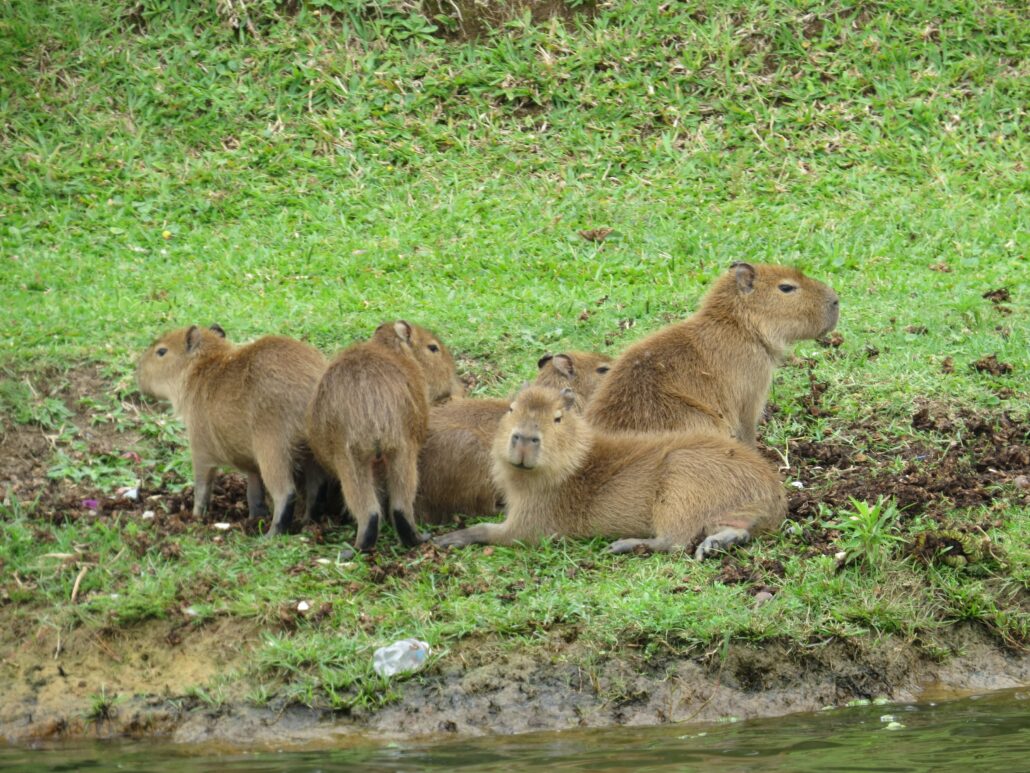
The capybaras are known as the “water pig”, and they are extraordinary creatures that reside in South America. As the largest rodent in the world, these semi-aquatic mammals have evolved to thrive in wetlands and riverside habitats.
Capybaras boast a fascinating adaptation for aquatic life, possessing webbed feet that aid them in swimming with ease. Their dense fur keeps them warm while submerged, and their eyes, ears, and nostrils are strategically positioned on top of their heads, allowing them to stay alert while their bodies remain mostly submerged in the water.
Capybaras are incredibly social animals, forming tight-knit herds that can consist of up to 30 individuals. By nibbling and cleaning each other’s fur, they reinforce their strong social bonds, cultivating a sense of camaraderie among them.
Symbolising harmony and togetherness, these friendly, gentle creatures have earned a special place in the hearts of many.
11. Chinchilla
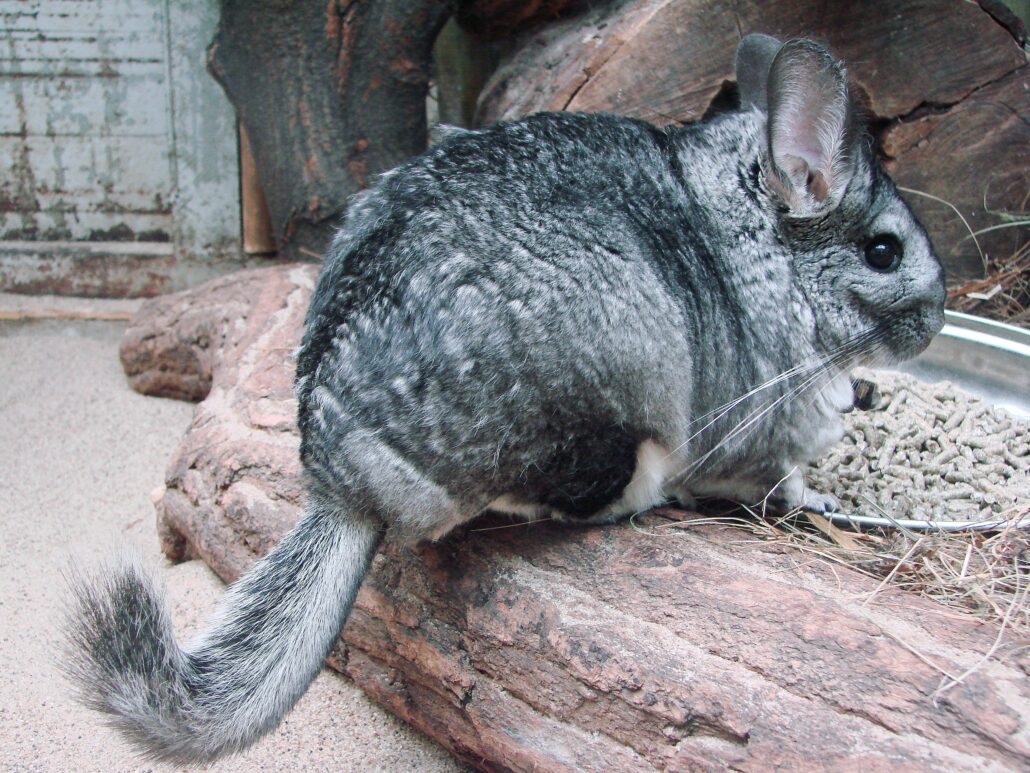
With their irresistibly fluffy appearance and luxurious fur, chinchillas have won the admiration of people worldwide. Originating from the Andes Mountains in South America, these agile rodents have adapted to the high altitudes and chilly temperatures of their native habitat.
Chinchillas possess a unique feature – their incredibly dense fur, which is approximately 30 times denser than that of a human. This exceptional fur provides them with superb insulation against the cold, enabling them to thrive in their mountainous homes.
They can navigate the darkness well because of their large eyes and keen senses, making them well-equipped to find food and shelter in the dark. Furthermore, chinchillas are known for their acrobatic abilities, which enable them to evade predators and move through rocky terrain efficiently.
However, their wild populations are threatened by habitat loss and overhunting for their valuable fur. Although these adorable creatures are popular as pets, there are conservation concerns regarding their wild populations.
12. Chipmunk
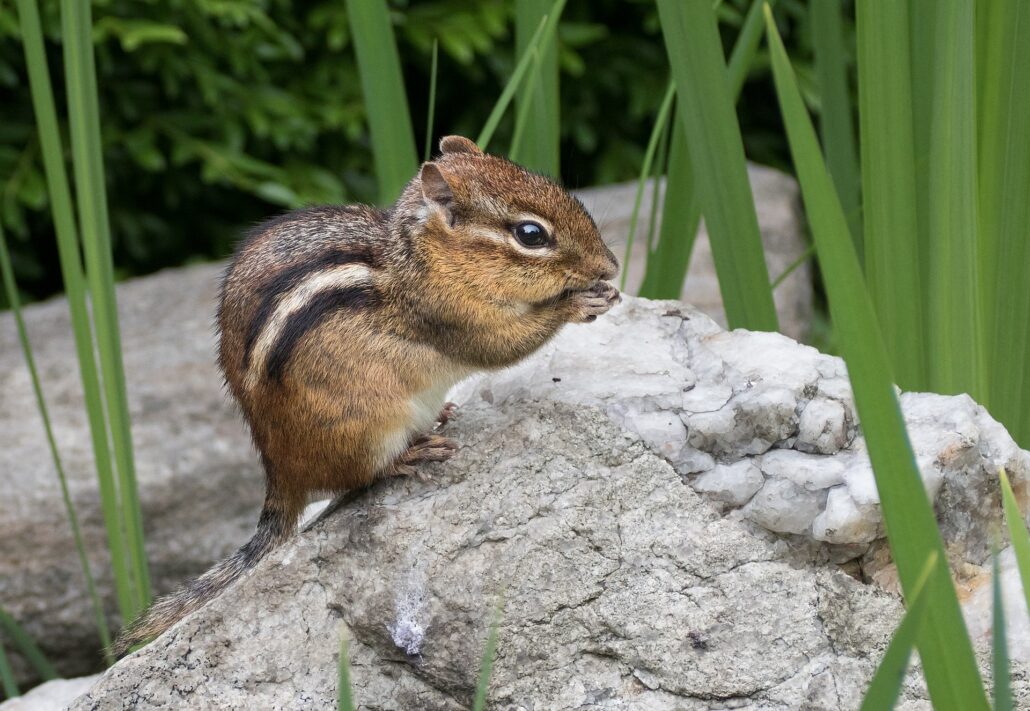
The chipmunk, a small and vibrant rodent, is a delightful sight often found scurrying through forests and gardens in North America. Their distinctive appearance, marked by alternating stripes along their backs and vibrant facial markings, makes them easily recognisable.
Chipmunks are highly skilled burrowers, crafting complex tunnel systems underground that serve as both shelter and food storage. Their cheek pouches are another intriguing feature, allowing them to gather and transport food, such as nuts and seeds, to their burrows for storage or consumption.
Active during daylight hours, chipmunks showcase boundless energy, darting between bushes and trees in search of food and communicating with each other through characteristic “chip-chip-chip” vocalisations.
Chipmunks disperse seeds in the forest ecosystem to ensure the propagation of plants and to sustain predators like hawks, owls, and snakes. Seeing these vivacious creatures reminds us that our natural environment is full of vibrant life and should be protected for future generations.
13. Crab
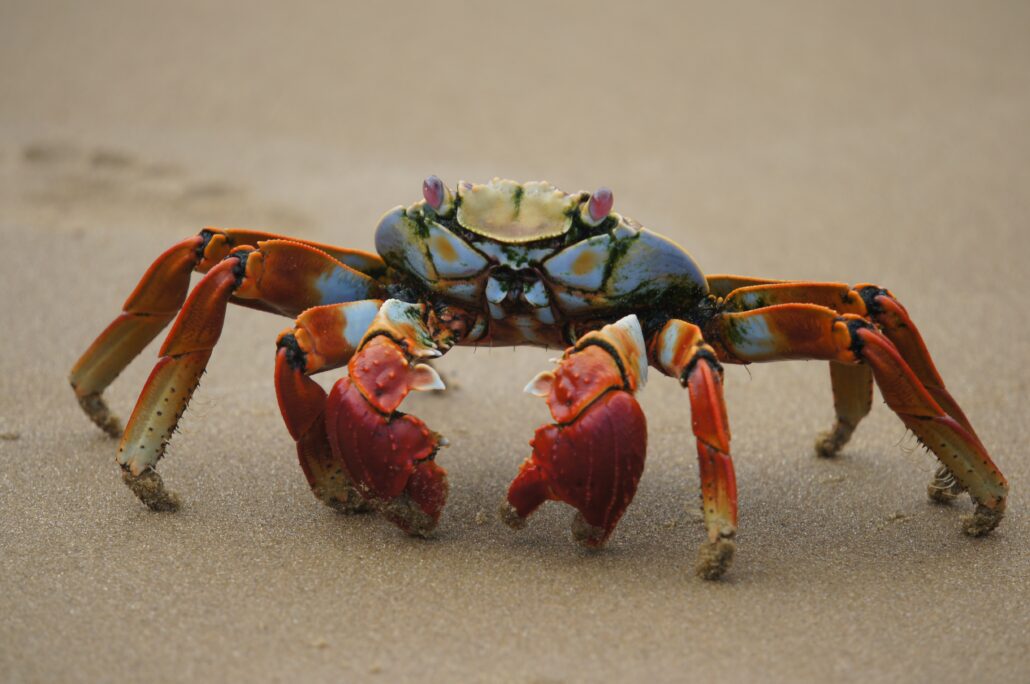
Crabs are interesting crustaceans that live in a variety of marine environments, from sandy beaches to deep ocean floors. Their distinctive sideways scuttling and tough exoskeletons make them easily identifiable.
The sharp claws of crabs allow them to catch prey, defend themselves, and excavate burrows for shelter. As they feed on dead organisms and algae, they contribute to nutrient cycling, and they maintain ecological balance in their ecosystems.
With their diverse species and fascinating behaviour, crabs continue to captivate marine enthusiasts and beachcombers alike, leaving their mark on the intricate web of life in the oceans.
14. Clownfish
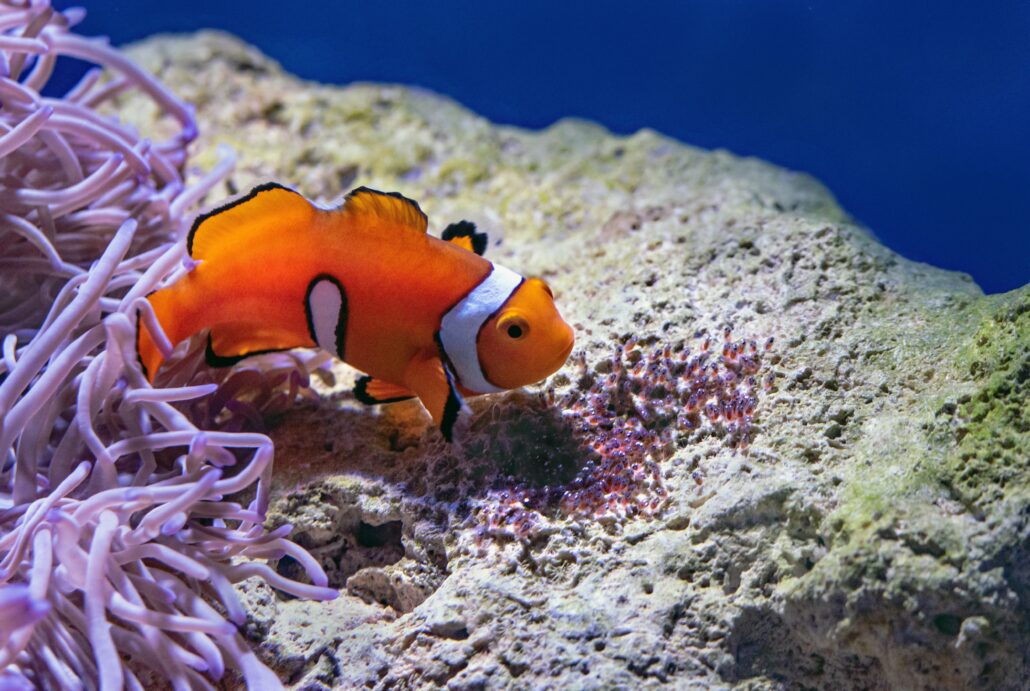
Clownfish, with their vibrant colours and playful demeanour, are among the most beloved marine creatures. Living in symbiosis with sea anemones, they are protected by the anemone’s stinging tentacles, while providing food and cleaning services in return.
These small fish exhibit remarkable adaptability, thriving in coral reefs across the Indian and Pacific Oceans. They have the unique ability to change their sex, with the dominant individual in a group becoming the female, and the second-ranking one transitioning to a male.
Their endearing appearances and the heartwarming tale of “Finding Nemo” have made them popular aquarium pets, though it is essential to practice responsible and sustainable pet ownership to protect wild clownfish populations and the delicate coral reef ecosystems they call home.
15. Cobra
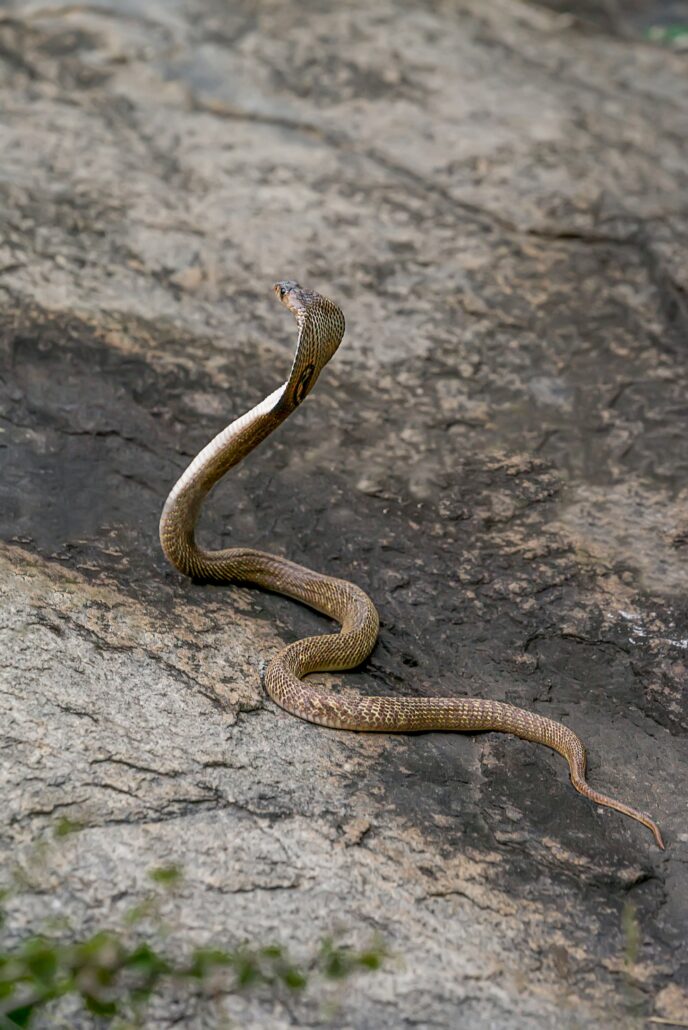
Cobras, although awe-inspiring and fearsome, are remarkable creatures with important roles in their ecosystems. As venomous snakes, they have evolved potent neurotoxins to immobilise and kill their prey. Cobras’ iconic hoods, displayed when they feel threatened, serve as a warning to potential predators and humans alike.
Cobras have a fierce reputation and are unique to the environment. Cobras control rodent populations, as they mostly eat mice, rats, and other small mammals, becoming an important link for the ecosystem’s balance.
Although they have strong characteristics, it’s important to show respect and caution when we encounter those snakes, as they are both dangerous for humans due to their venomous nature but also we need to ensure their well-being and safety.
Conservation efforts are essential to protect these incredible creatures, preserving their habitats and ensuring the coexistence of humans and cobras in harmony with nature.
16. Condor
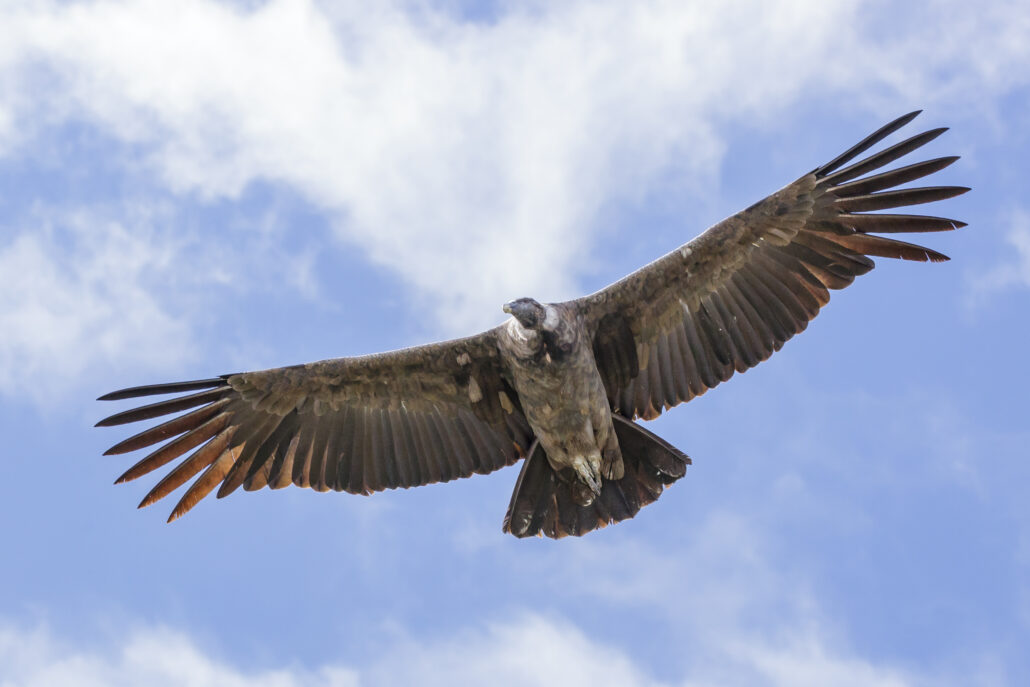
One of the largest flying birds in the world, the condor is an awe-inspiring and majestic bird. Distinguished in the Andean condor and the California condor, these remarkable creatures are native to the Americas.
Condors are symbols of strength and freedom with their distinctive black plumage and striking white feathers. In search of carrion to scavenge, they hover gracefully through the skies like gliders.
The condor serves as nature’s cleanup crew by removing decaying animal carcasses and preventing the spread of disease in their ecosystems.
However, because of habitat loss and poaching, these magnificent bird populations have faced challenges, making conservation efforts vital to protecting them and preserving their vital role in nature.
17. Caimans
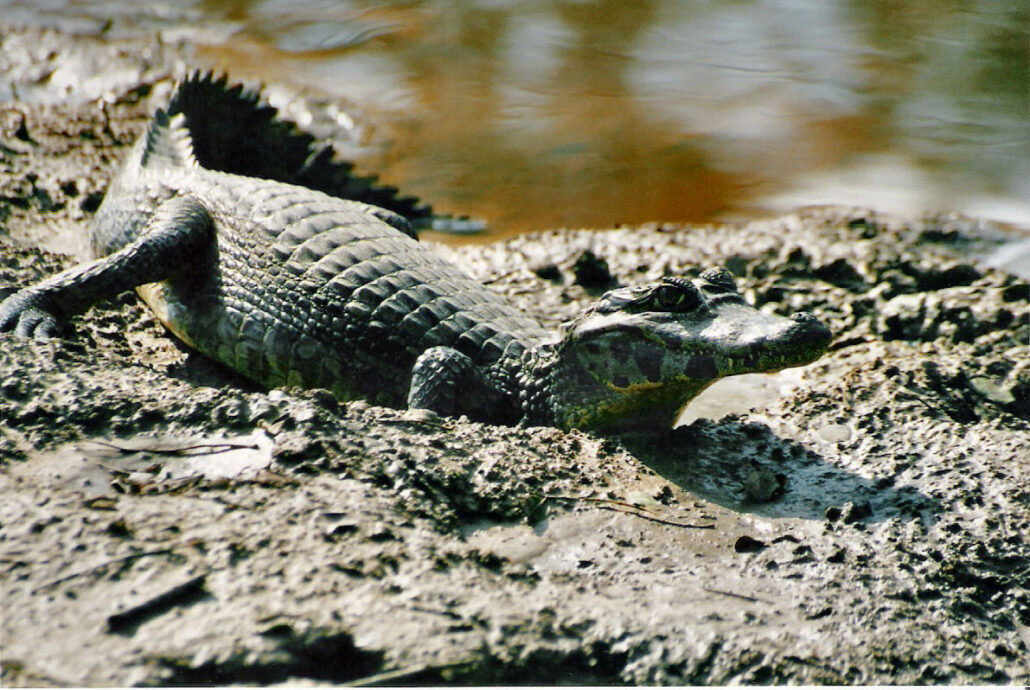
Caimans are fascinating reptiles closely related to alligators and crocodiles. These semi-aquatic creatures are well-adapted to thrive in a wide range of habitats, including lakes, ponds, rivers, and swamps in Central and South America.
Their robust, armored bodies provide protection from predators, and their powerful tails enable them to easily navigate the water. In addition to preying on fish, birds, and small mammals, caimans are opportunistic carnivores.
Their presence in wetland ecosystems is essential for regulating prey populations, balance, and supporting biodiversity.
Despite facing some threats due to habitat loss and illegal hunting, many caiman populations are relatively stable, thanks to conservation efforts and protective measures.
18. Cuttlefish
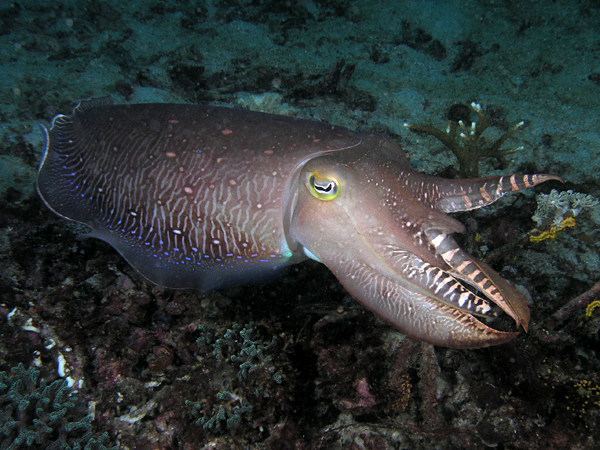
Cuttlefish are incredible marine creatures known for their exceptional intelligence and fascinating color-changing abilities. Their cephalopod status places them in the same family as octopuses and squids.
In order to control their buoyancy, cuttlefish have an elongated body and a unique internal shell called a cuttlebone. Using chromatophores – specialized skin cells – they camouflage themselves to blend seamlessly into their surroundings or communicate with each other by changing their color and texture.
Their sophisticated hunting techniques involve using their tentacles to capture prey with lightning speed. These captivating creatures are renowned for their ability to learn and exhibit complex behaviors, making them popular subjects for research and marine enthusiasts worldwide.
Despite being short-lived creatures, cuttlefish are crucial members of marine ecosystems, contributing to the delicate balance of life beneath the waves.
19. Cassowary
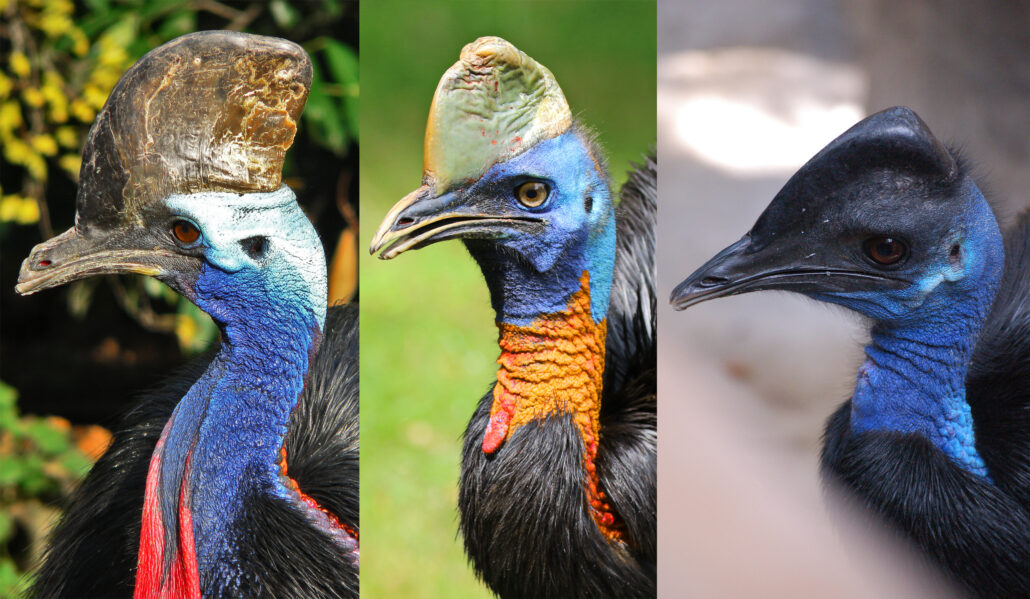
The cassowary is a striking and majestic bird native to the rainforests of Australia, New Guinea, and nearby islands. These large flightless birds possess vibrant and distinctive casques on their heads, which add to their remarkable appearance.
Cassowaries are known for their powerful legs and fast running ability, capable of speeds up to 30 mph. As seed dispersers and forest regenerators, they play an essential role in rainforest ecosystems.
However, cassowaries face threats from habitat loss and human activities, making conservation efforts crucial to protect these remarkable birds and ensure the preservation of their lush rainforest homes.
20. Coati
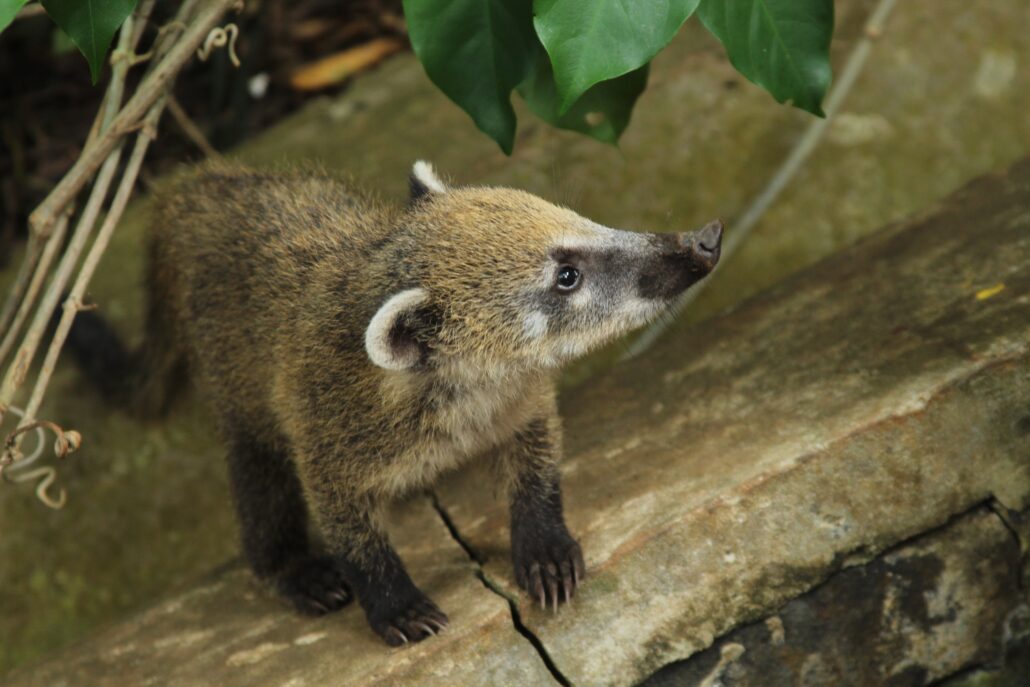
Coatis is one of the most fascinating mammals from the Americas, known for its elongated snout and ringed tail. A member of the raccoon family, this intelligent creature can survive in forest, grassland, or mountain habitats.
To find food, coatis use sharp claws and prehensile tails to navigate through trees. They have a diverse diet, foraging for fruits, insects, small vertebrates, and even bird eggs.
Coatis live in tight-knit social groups called bands, which can consist of several females and their young, led by a dominant male. These playful and curious animals are captivating to observe, but it’s essential to respect their space and allow them to thrive in their natural environments without interference.
21. Cockatoo
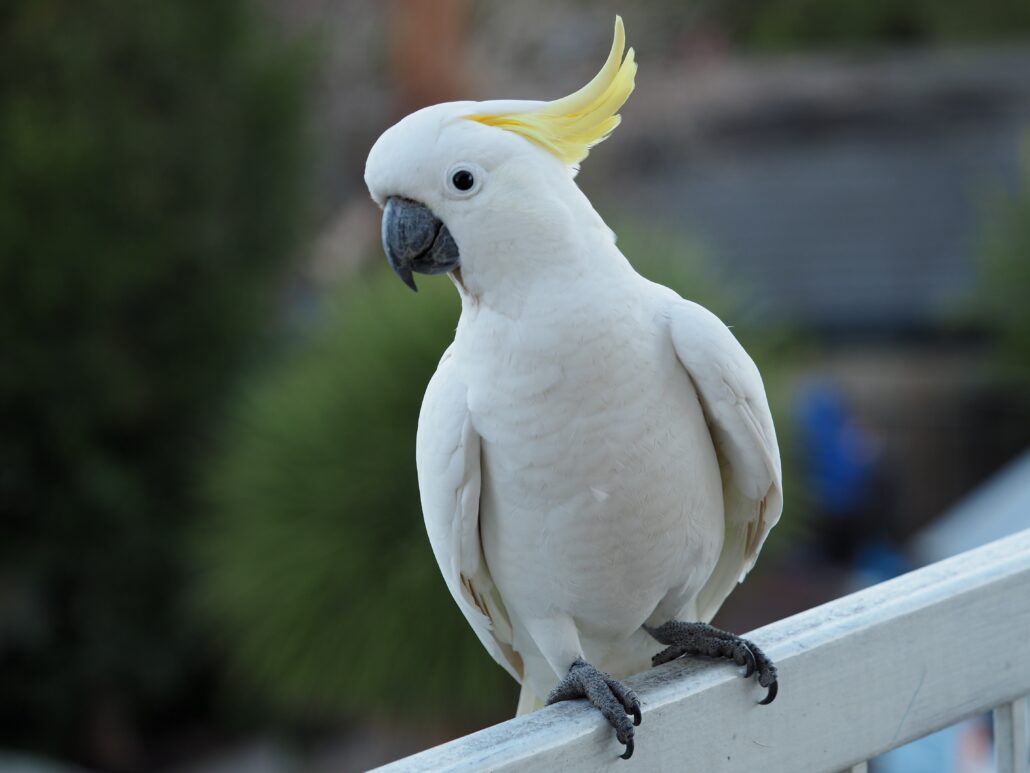
Cockatoos are charismatic and intelligent parrots known for their striking crests and vibrant plumage. Native to Australia and nearby islands, these social birds are highly vocal and use their calls to communicate with their flock members.
A cockatoo’s strong beak allows it to crack open nuts and seeds. In some regions, they are popular pets due to their high intelligence and ability to learn tricks and mimicry.
However, it’s essential to understand the responsibility of pet ownership, as cockatoos have specific needs and require mental stimulation and social interaction to lead fulfilling lives.
In the wild, these delightful birds contribute to the ecosystem by aiding in seed dispersal and pollination, highlighting their significance in maintaining the balance of their native habitats.
22. Caiman Lizard
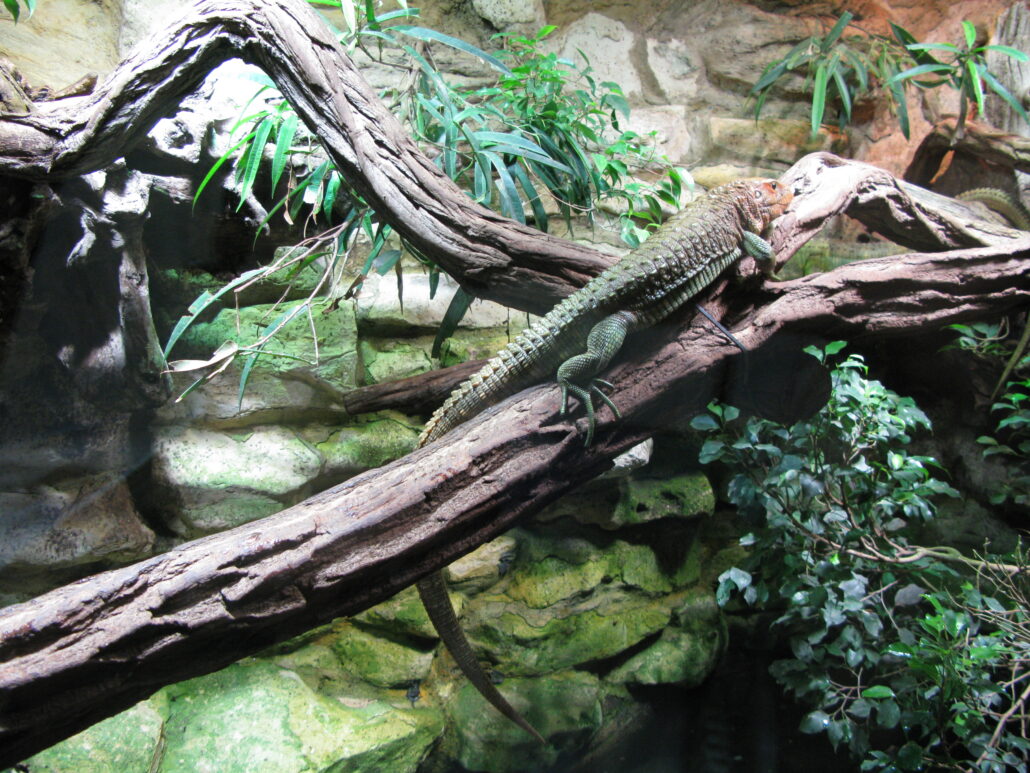
South American rainforests are home to the fascinating caiman lizard. Despite its resemblance to caimans, it is neither a caiman nor a crocodile.
The scales of caiman lizards have striking green colours with dark bands, making them an excellent camouflage agent among lush vegetation. The strong legs and sharp claws of these semi-aquatic creatures allow them to swim and climb effortlessly.
Snails, mollusks, and other aquatic creatures are crushed and eaten by their powerful jaws and sharp teeth. The caiman lizard is vital to the ecosystem of the rainforest because it controls the population of aquatic invertebrates.
To ensure their survival and the preservation of these important ecological roles, rainforests must preserve the habitats of unique lizards.
23. Cougar
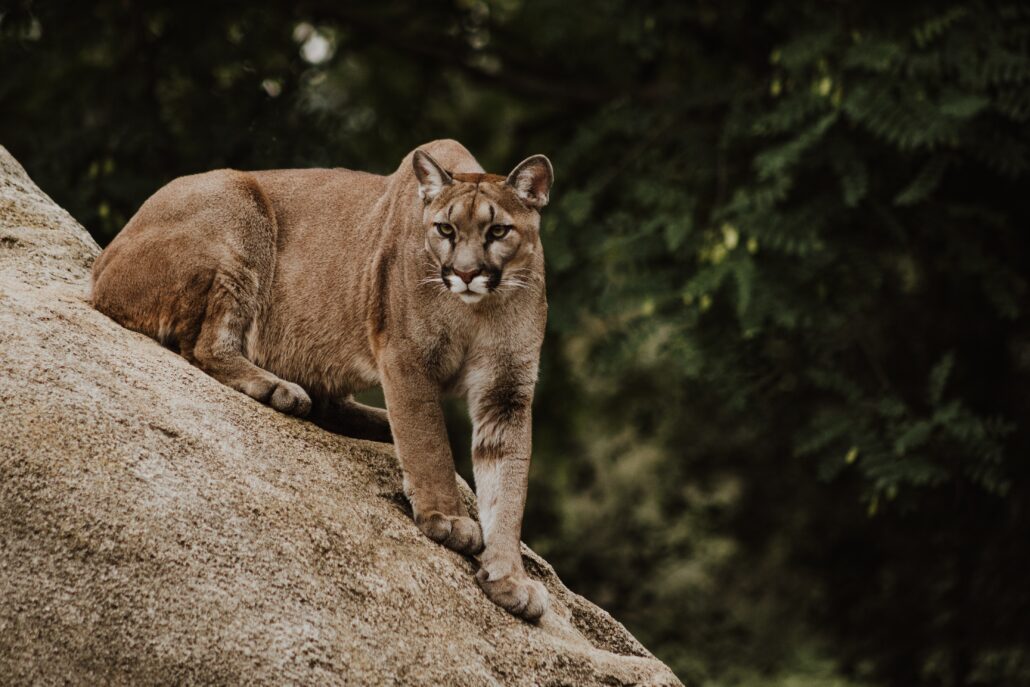
Cougars, also known as mountain lions or pumas, are majestic and elusive big cats that live in the Americas.
Cougars are powerful hunters and skilled climbers due to their tawny fur and graceful movements. Their range extends from North America to South America, and they adapt to a variety of habitats, including forests, mountains, and deserts.
Usually active at night, cougars ambush deer, small mammals, and livestock taking advantage of their solitary nature.
Despite their elusive nature and tendency to avoid human interaction, it is vital to respect their habitats and coexist peacefully to ensure the conservation of these magnificent wild cats and their ecosystems, as well as our safety.
24. Cormorant
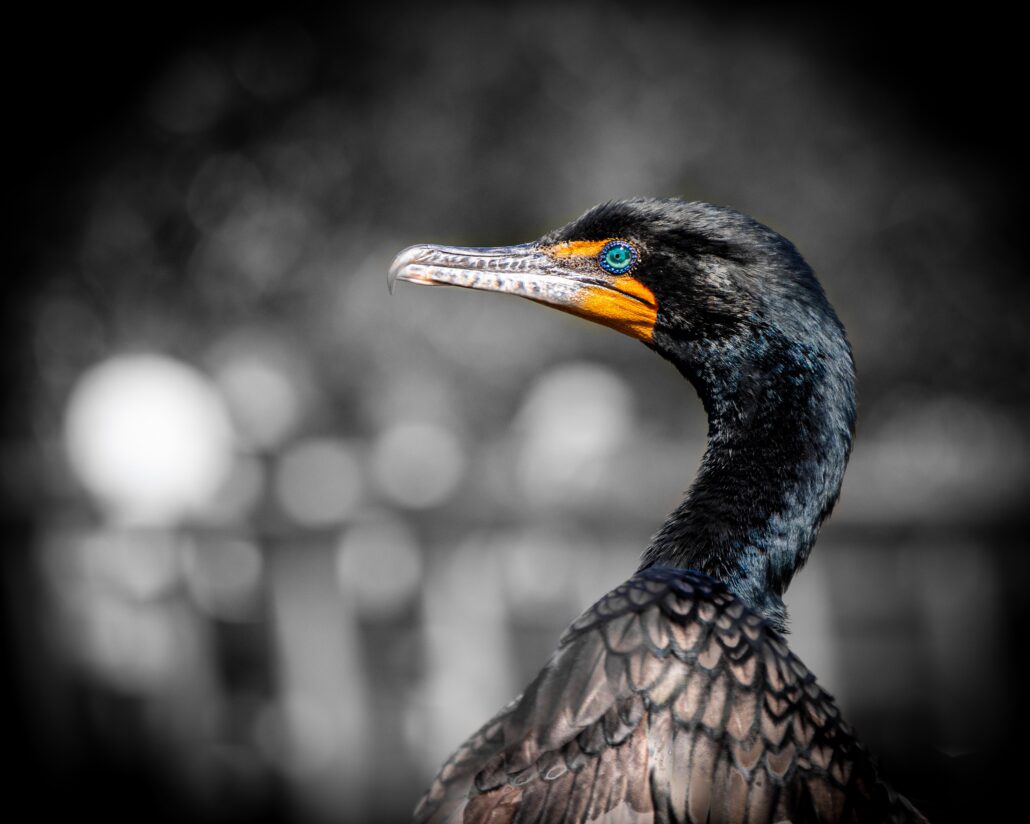
Cormorants are fascinating aquatic birds found in various parts of the world, from coastal areas to inland lakes and rivers.
These expert divers have streamlined bodies and webbed feet, which make them excellent underwater swimmers as they hunt for fish, their primary food source.
After diving, cormorants can often be seen perched with their wings spread out, drying them in the sun. This unique behaviour has given rise to their nickname “the drying bird.” It is common for cormorants to nest and roost in large colonies, making them highly social creatures.
Birdwatchers and nature enthusiasts alike enjoy observing and photographing them because of their distinctive appearance and engaging behaviours.
25. Collie

The collie is a highly intelligent and loyal breed of dog that has won the hearts of dog lovers around the world. Known for their striking beauty and flowing coats, collies have various coat colors and patterns, with the rough and smooth varieties being the most common.
Collies are renowned for their herding abilities, making them excellent working dogs for livestock farmers. They have a strong herding instinct and are highly responsive to training, making them versatile companions for various tasks.
Besides their remarkable herding skills, collies are known for their affectionate and gentle nature, making them wonderful family pets. Their loyalty and devotion to their human families have solidified their place as cherished and trusted companions in households for generations.
26. Crayfish
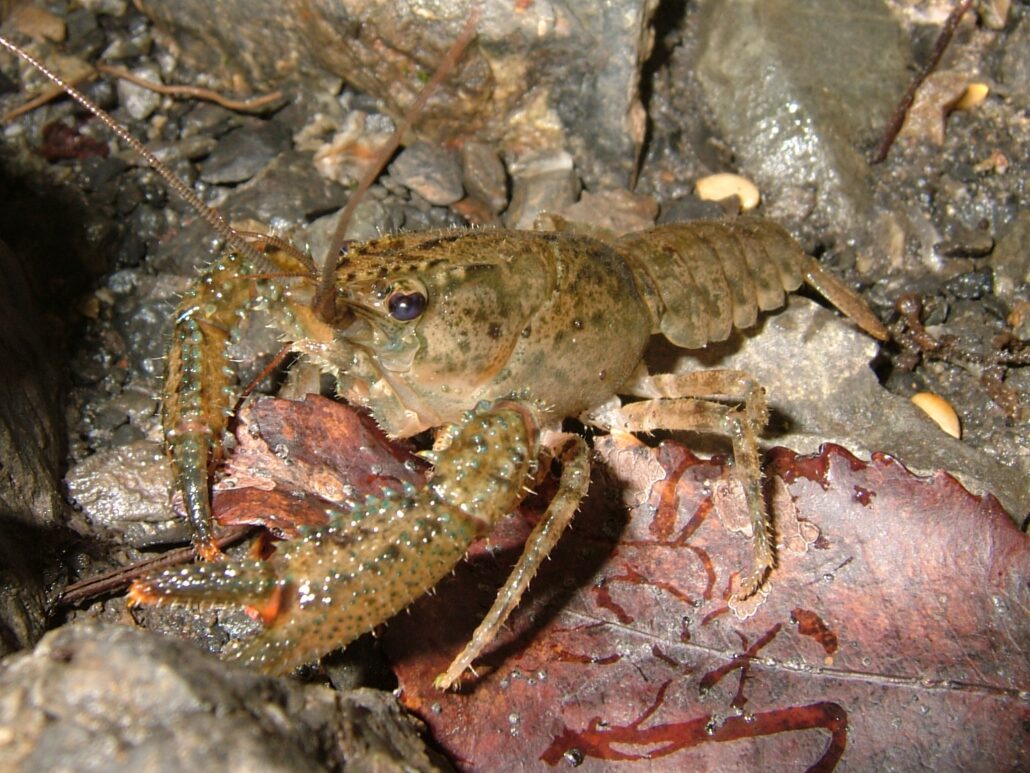
A crawfish, also known as a crawdad, is a small freshwater crustacean found throughout the world. The fascinating creatures are characterized by a hard exoskeleton and ten legs, including two large pincers.
Using decaying organic matter as food and helping to clean up their habitat, crayfish are important scavengers in their ecosystems. Several fish, birds, and mammals eat them as prey, making them an important part of the food chain.
Scientists and aquarium owners alike have turned to crayfish for their interesting behaviors and intriguing biology.
27. Cottonmouth Snake
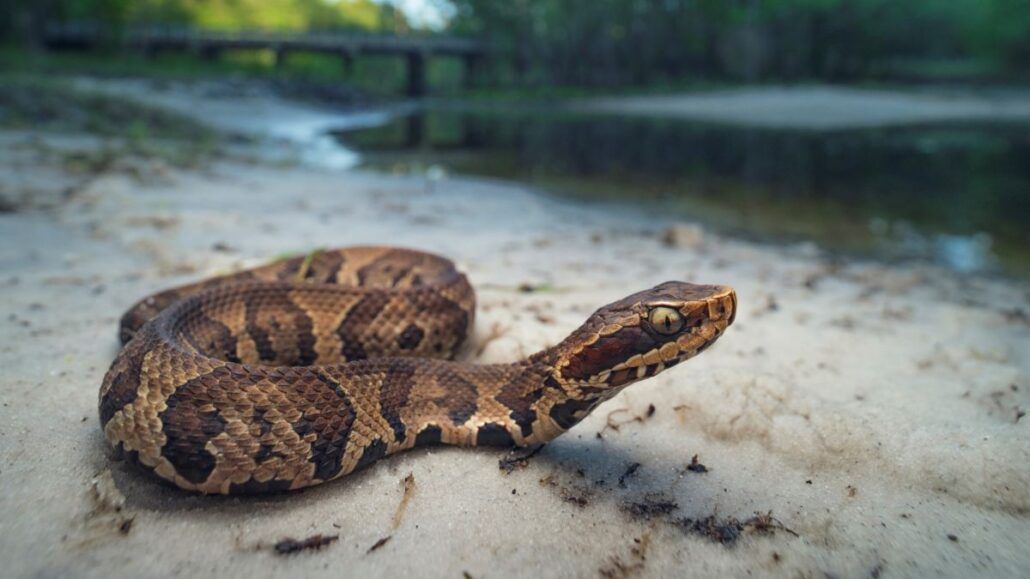
Cottonmouth snakes, or water moccasins, are venomous reptiles found primarily in the southeastern United States. This species is named after the white color inside its mouth, which it displays as a warning when threatened.
Semiaquatic snakes inhabit swamps, marshes, and riverbanks, among other wetlands. Cottonmouths are opportunistic predators that feed on fish, amphibians, birds, and small mammals.
The snakes are venomous, but are typically shy and avoid humans. To promote peaceful coexistence with these unique reptiles, it is imperative to respect and caution snakes in the wild, as well as to understand their role in the ecosystem.
28. Cricket
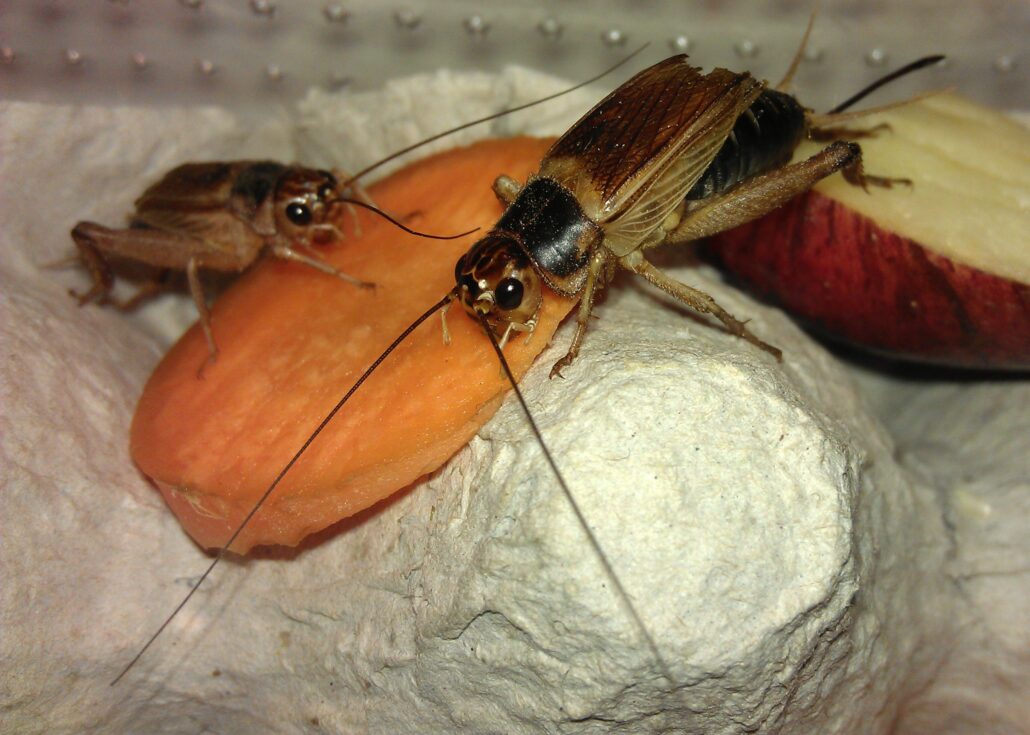
Crickets are small, chirping insects that make distinctive sounds when it gets warm in the evenings. Crickets tend to live in grasslands and wooded areas, where they make distinctive chirping sounds, which are used for communication, attracting mates, and establishing territories.
They play vital roles in their ecosystems, serving as both predators and prey. It is common for crickets to consume plant matter, insects, and other organic matter as they are omnivores.
Birds, reptiles, and small mammals feed on them, making them valuable food sources. They have become beloved symbols of warm summer nights and delightful additions to the insect world due to their melodious songs and presence in nature.
29. Cuscus
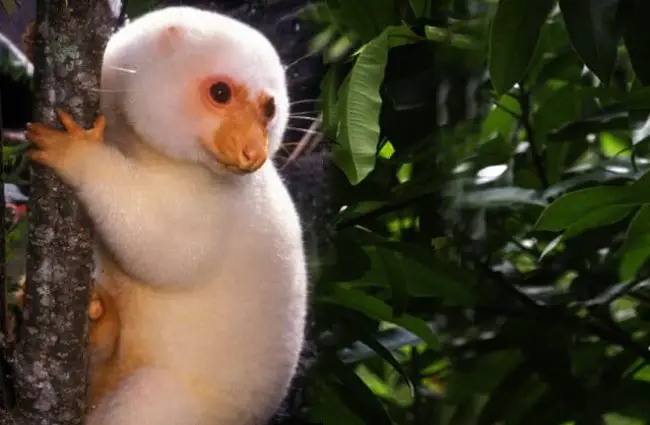
The cuscus is an adorable and arboreal marsupial found in parts of Australia, New Guinea, and nearby islands. With their round, teddy-bear-like appearance and large eyes, cuscus are known for their captivating charm.
They have a prehensile tail that helps them move through trees and grasp branches while foraging for leaves, fruits, and flowers.
As nocturnal creatures, cuscus is most active during the night, seeking shelter in tree hollows or dense foliage during the day. Their gentle and docile nature has made them popular among locals, often being kept as pets.
However, conservation efforts are crucial to protect wild cuscus populations and preserve the delicate balance of their rainforest habitats.
30. Cichlid (Fish)

From Africa to Central and South America, the cichlid family is a diverse and colourful family of freshwater fish. Cichlids are popular aquarium fish due to their vibrant hues and intricate patterns.
The social fish is known for its complex behaviors, including defending their territory and building nests. An omnivore, cichlids eat plants, invertebrates, and even smaller fish.
There are different sizes available, from a few centimeters to impressive giants. Cichlids are a fascinating group of fish to study because of their diverse nature and adaptability to different environments.
They provide insights into different aspects of fish behavior and evolution because of their diverse nature and adaptability to different environments.
31. Coral

The coral reef ecosystem is one of the most diverse and vibrant ecosystems on earth because of corals. The hard calcium carbonate exoskeletons that coral reefs are made of are secreted by these small, soft organisms.
During their life cycle, corals are symbiotic with photosynthetic algae called zooxanthellae that provide nutrients and give the reef its stunning colors. Numerous fish species are nursed on coral reefs, and other marine organisms rely on coral reefs for shelter and food.
However, coral reefs face threats from climate change, ocean acidification, and human activities. This makes their conservation critical to preserving our oceans’ beauty and biodiversity.
32. Coelacanth (Fish)
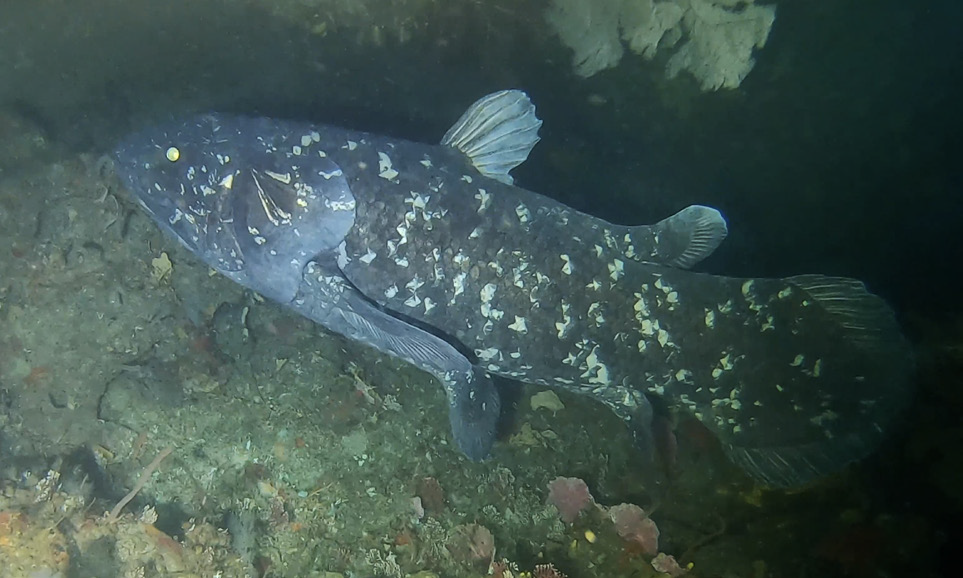
There is a remarkable story behind the discovery of the coelacanth, an ancient and fascinating fish. The coelacanth was once thought to be extinct for millions of years before it was rediscovered in 1938. Unlike most modern fish, coelacanths have lobed fins and primitive lungs.
These deep-sea dwellers live in dark waters and have a slow metabolism, so they can live in low-oxygen environments. It is worth mentioning that Coelacanths are elusive creatures that provide valuable insights into vertebrates’ evolution and biology.
33. Crowned Crane
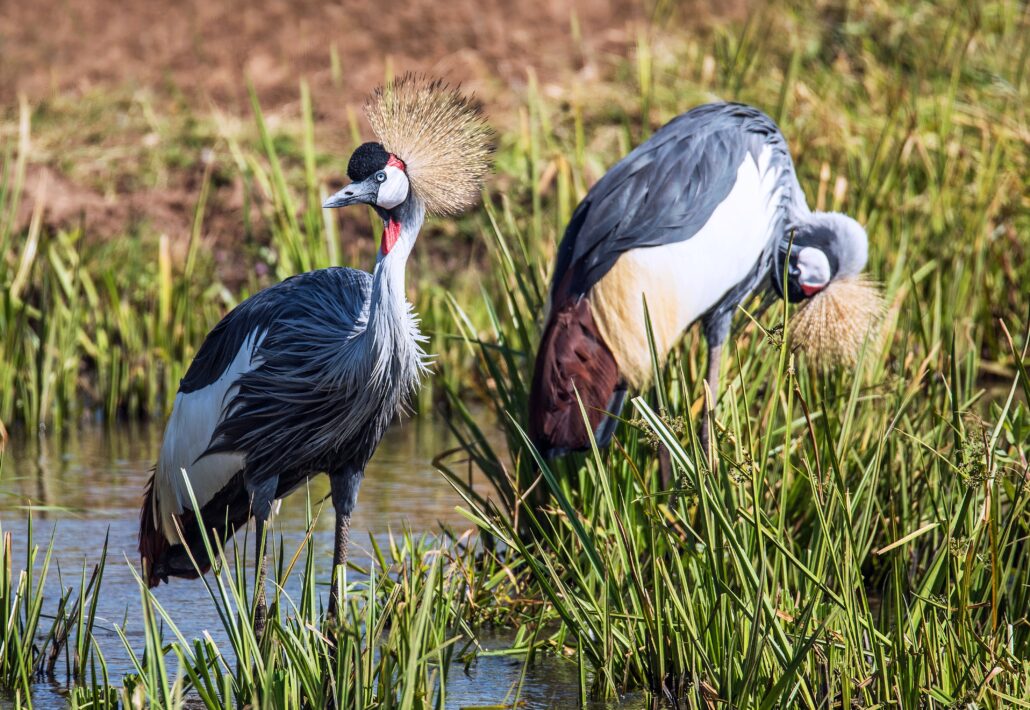
The crowned crane is a spectacular and elegant bird native to parts of Africa. As one of the most stunning bird species, crowned cranes are adorned with golden tufts of feathers on their heads, which give them their regal appearance.
These graceful birds are known for their impressive courtship dances, where they leap, bow, and spread their wings in intricate displays to attract mates.
Crowned cranes primarily inhabit wetland areas, where they forage for insects, seeds, and small vertebrates.
Unfortunately, they face threats from habitat loss and human activities, making conservation efforts crucial to protect these magnificent birds and ensure the survival of their wetland habitats.
34. Civet
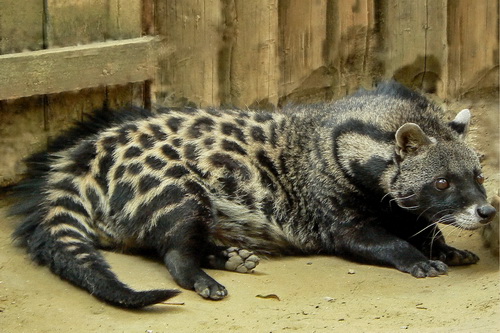
Civets are fascinating small to medium-sized mammals found throughout Asia and Africa. Cat-like in appearance, with slender bodies and sharp claws, they are keenly aware of their surroundings.
The musky secretion produced by some species serves as a signaling and territorial marking tool. The civet is mainly nocturnal and omnivorous, eating fruits, insects, small vertebrates, and even carrion.
Certain species excel at climbing, while others prefer to stay on the ground.
35. Caterpillar
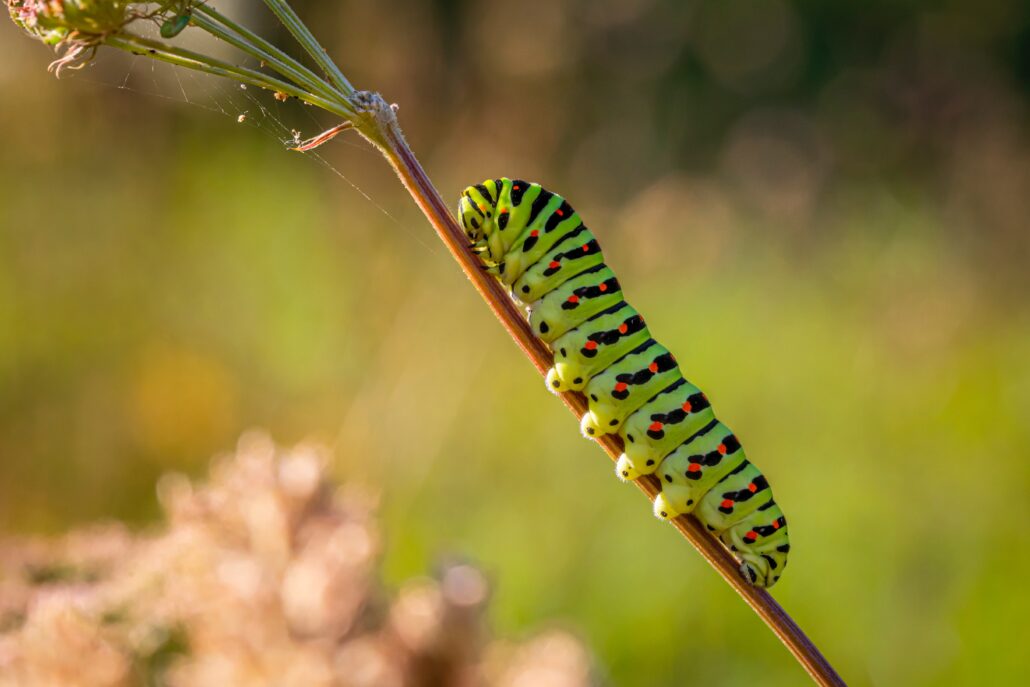
Caterpillars are the larval stage of butterflies and moths, fascinating creatures undergoing incredible transformations. These soft-bodied insects have long, worm-like bodies and come in various colors and patterns, some with striking markings to deter predators.
They are voracious eaters, primarily consuming leaves and plant material to fuel their growth before entering the next stage of their life cycle.
Undergoing metamorphosis, they encase themselves in chrysalides or cocoons, where they undergo a miraculous transformation, eventually emerging as beautiful and graceful butterflies or moths.
The caterpillar’s life cycle is a testament to the wonders of nature, showcasing the diversity and complexity found in the insect world.
36. Chameleon
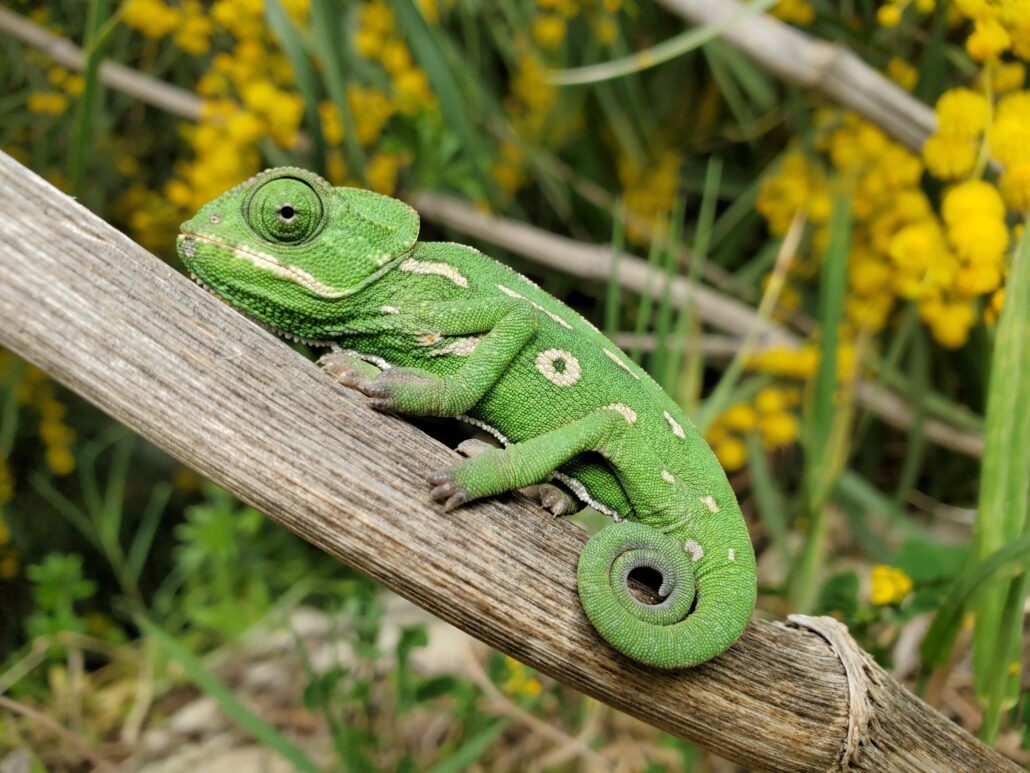
Chameleons are one of the most incredible animals on earth as they have the ability to change color and move their eyes independently. They mostly find home in Southern Europe, Asia, and the Middle East.
Their ability to change color is not only used for their safety, but they also use it to communicate with each other, regulate the temperature in their bodies, camouflage but also to emotionally express themselves.
It’s quite admirable that chameleons use their long and sticky tongues to catch and eat insects with precision. In addition to their other traits, chameleons are able to have 360-degree views, without moving their heads.
They move slowly making it easy to adapt to arboreal life. It is worth mentioning that they spend most of their time in the trees.
37. Chi Chi

Chi Chi is an adorable and affectionate dog with a playful personality. This fluffy canine companion has won the hearts of many with its wagging tail and warm, expressive eyes.
Known for being gentle and friendly, Chi Chi enjoys spending time with its human family, engaging in games, and receiving belly rubs. Whether playing fetch in the park or cuddling up on the couch, Chi Chi brings joy and comfort to those around it.
This lovable dog is a wonderful addition to any home, offering unwavering loyalty and companionship that leaves a lasting pawprint on the hearts of everyone it meets.
38. Chartreux

The Chartreux is a charming and intelligent breed of cat with a distinctive appearance and a playful nature. Known for its mesmerizing copper or gold eyes and dense, blue-gray fur, this feline friend is easily recognizable and captivating to behold.
The Chartreux has a sweet and gentle temperament, making it a loving companion that enjoys spending time with its human family. Whether playing with toys, exploring its surroundings, or simply lounging in a sunlit spot, the Chartreux brings a sense of calm and joy to any household.
This quiet and thoughtful cat is known for its quiet voice and contented purring, creating a peaceful and soothing ambiance. The Chartreux’s endearing personality and striking looks have made it a beloved breed for cat enthusiasts around the world, and its quiet companionship is truly a treasure for those lucky enough to share their lives with one another.
39. Cheagle

The Cheagle is an adorable and affectionate hybrid dog breed, resulting from the cross between a Chihuahua and a Beagle. With its charming mix of traits from both parent breeds, the Cheagle is a delightful companion, known for its small size and big personality.
These little dogs have a playful and energetic nature, enjoying games and outdoor activities with their human family. Despite their petite stature, Cheagles are confident and social, getting along well with children and other pets.
They are known for their loyalty and devotion to their owners, forming strong bonds that make them wonderful lapdogs and loyal friends.
With their expressive eyes and endearing antics, the Cheagle is an adorable addition to any home, bringing joy and love to everyone lucky enough to call one their furry friend.
40. Chimaera
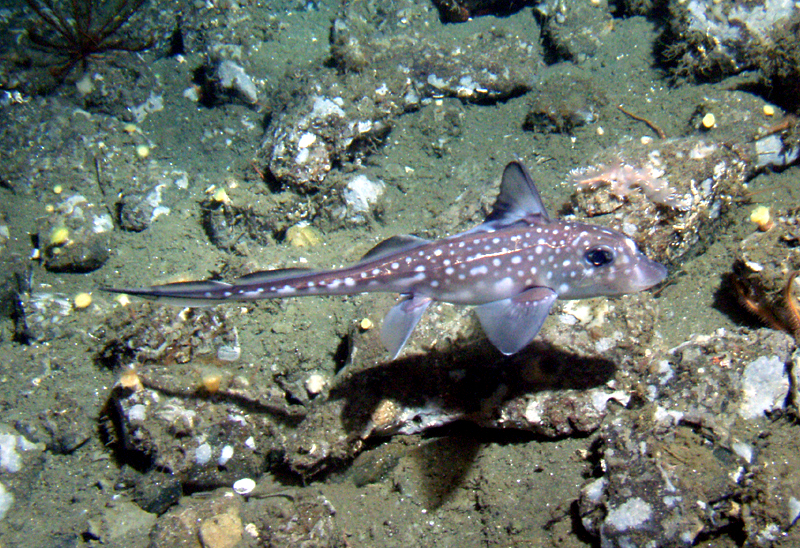
The Chimaera, also known as the “ghost shark” or “ratfish,” is a fascinating and ancient deep-sea creature belonging to the family Chimaeridae. Despite its name, the Chimaera is not a true shark but rather a distant relative, and it holds a unique place in the evolutionary history of fish.
This enigmatic fish possesses a distinctive appearance with a long, tapered tail, large pectoral fins resembling wings, and a prominent frontal appendage that gives it an otherworldly appearance.
The Chimaera’s habitat in the depths of the ocean, often thousands of feet below the surface, has contributed to its mysterious reputation.
With its extraordinary adaptations to the deep-sea environment, such as specialized sensory organs and slow-moving habits, the Chimaera remains a captivating and little-understood denizen of the deep, adding to the intrigue and wonder of the ocean’s hidden realms.
41. Chipoo
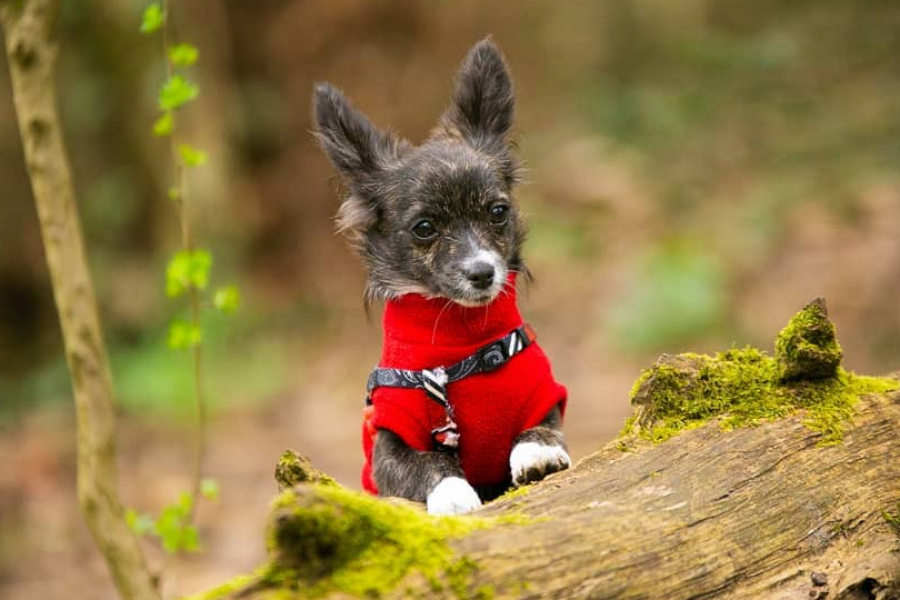
The Chipoo, a delightful designer dog breed, is a charming combination of a Chihuahua and a Poodle. With its adorable appearance and affectionate nature, the Chipoo has quickly become a beloved companion for dog lovers.
These small dogs inherit the best traits from both parent breeds, combining the intelligence and hypoallergenic coat of the Poodle with the spunky personality of the Chihuahua.
Chipoos are known for their playful and energetic demeanor, enjoying interactive playtime and cuddles with their human family. Their small size makes them ideal for apartment living, and their friendly disposition makes them great with kids and other pets.
With their expressive eyes and perky ears, the Chipoo is an endearing addition to any home, bringing joy and happiness to the lives of those fortunate enough to have one as their furry friend.
42. Corella
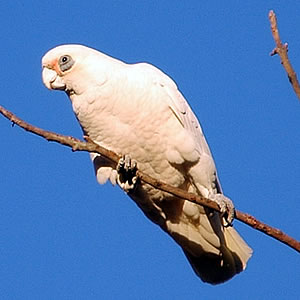
The Corella, also known as the Little Corella, is an enchanting parrot species native to Australia. With its striking white plumage, bright orange cheek patches, and expressive blue eyes, the Corella has a captivating and charming appearance.
These social and intelligent birds are highly sociable, forming large flocks that can be seen foraging and flying together in the Australian skies. Corellas are skilled vocalists, known for their repertoire of whistles, squawks, and chirps, which they use for communication and bonding within their flock.
They have a varied diet that includes seeds, fruits, and vegetation, and their strong beaks are adept at cracking open nuts and seeds.
As delightful avian companions, Corellas are popular pets, captivating their owners with their playful antics and affectionate nature.
Their inquisitive and social personalities make them cherished additions to households that value the joys of bird companionship.
43. Cuckoo
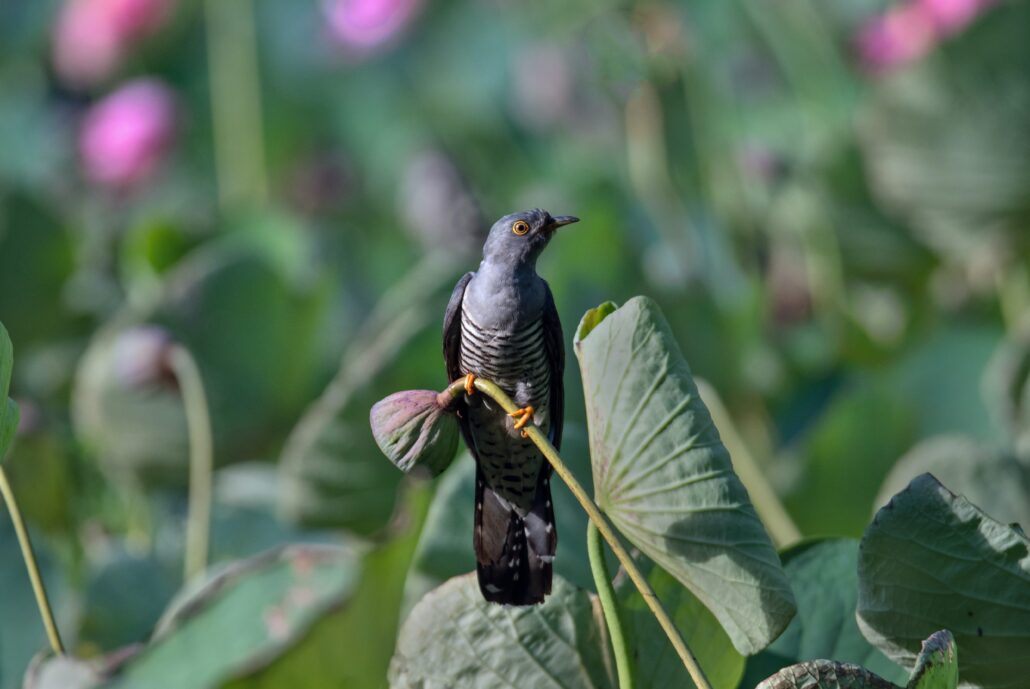
Cuckoos are enigmatic and fascinating birds known for their unique behaviors and breeding habits. The cuckoo is a bird that is found worldwide, and it has captured the curiosity of both birdwatchers and naturalists alike.
Cuckoos are known for their brood parasitism, where they lay their eggs in the nests of other birds. Unsuspecting parents raise cuckoo chicks, often sacrificing their own children to raise them.
This clever adaptation allows the cuckoos to distribute their parenting responsibilities and increase their chances of survival. Cuckoos are typically excellent singers, and their distinctive calls, such as the familiar “cuckoo” sound, are often associated with the arrival of spring in many regions.
Their elusive nature and remarkable behaviors have made cuckoos subjects of wonder and admiration, symbolizing the intricate and sometimes puzzling dynamics of the natural world.
44. Conger Eel

The Conger Eel, a mysterious resident of the deep ocean, is a fascinating and beautiful creature. With its long, snake-like body and sharp teeth, the Conger Eel has an intimidating appearance that belies its elusive and nocturnal nature.
These eels prefer to hide in crevices and caves during the day, venturing out at night to search for prey. As opportunistic hunters, they feast on fish, crustaceans, and even smaller eels.
The Conger Eel’s ability to expand its jaws allows it to swallow relatively large prey, making it an efficient predator in its underwater realm. Despite its fearsome appearance, the Conger Eel is a vital part of the marine ecosystem, contributing to the delicate balance of ocean life.
Their adaptations and behaviors showcase the fascinating diversity found in the depths of the ocean, leaving us with a sense of wonder and awe at the hidden wonders beneath the waves.
Every species of animal contributes uniquely to our natural world’s complexity, creating a magnificent tapestry of diversity and wonder. Whether it is the graceful cheetah or the mysterious Conger Eel, every animal plays a vital role in preserving our fragile ecosystems.
Nature’s beauty and complexity remain a mystery to us as we watch these captivating creatures soaring, swimming, and roaming in their habitats. Keeping these creatures and their habitats alive for future generations becomes our solemn duty as stewards of this planet.
We can nurture a harmonious coexistence with the wondrous creatures of the wild by cultivating empathy and understanding, as well as undertaking conservation efforts, which will lead to a future where both flourish within the embrace of the enchanting diversity of the animal kingdom.
For more animals by letters lists:
